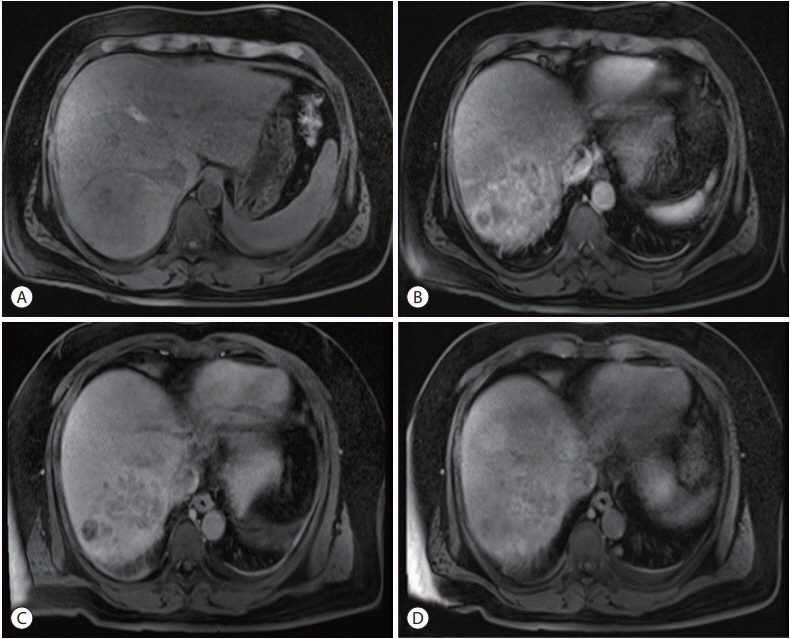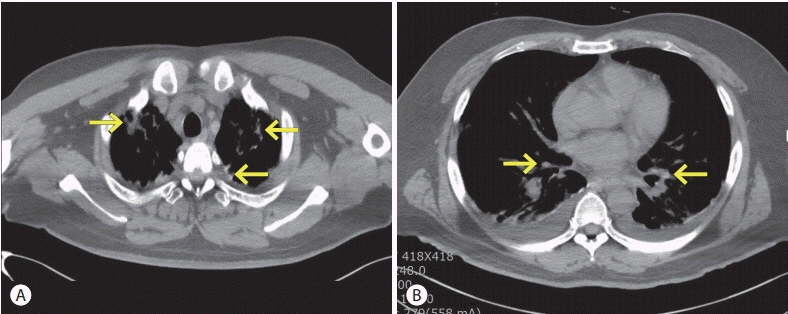J Liver Cancer.
2020 Mar;20(1):60-66. 10.17998/jlc.20.1.60.
Lipiodol Pneumonitis Following Transcatheter Arterial Chemoembolization for Hepatocellular Carcinoma
- Affiliations
-
- 1Department of Internal Medicine, College of Medicine, The Catholic University of Korea, Seoul, Korea
- 2Department of Radiology, College of Medicine, The Catholic University of Korea, Seoul, Korea
- KMID: 2505843
- DOI: http://doi.org/10.17998/jlc.20.1.60
Abstract
- Transcatheter arterial chemoembolization (TACE) is a useful palliative therapeutic modality for hepatocellular carcinoma (HCC). Postembolization syndromes, such as fever, abdominal pain, and elevated liver enzyme levels are commonly known complications of TACE. One post-TACE pulmonary complication, lipiodol pneumonitis, is rarely reported. Lipiodol pneumonitis after TACE appears to be associated with chemical injury due to accidental perfusion of lipiodol to the lung vasculature, promoted by arteriovenous shunts within the hypervascular HCC. Here, we report a 42-year-old man with unresectable HCC and hepatic vein thrombosis. The patient was initially treated with TACE. The following day after TACE, acute respiratory symptoms such as dyspnea and cough developed with decreased oxygen saturation. Chest X-ray and computed tomography showed multiple patches and diffuse ground-glass opacities in both lung fields, suggesting of lipiodol pneumonitis. The patient’s condition and radiologic abnormalities subsequently improved after 2 weeks of conservative treatment alone.
Figure
Cited by 1 articles
-
Lipiodol-induced Pneumonitis Following Transcatheter Arterial Chemoembolization for Hepatocellular Carcinoma
Heechul Nam
Korean J Gastroenterol. 2022;80(5):233-236. doi: 10.4166/kjg.2022.119.
Reference
-
1. Dai H, Ding H, Liu F, Yao Z, Li L, Li C, et al. Complications of chemoembolization for hepatic neoplasms. Saudi Med J. 2007; 28:1208–1212.2. Cho SH, Kim JH, Kim BS, Jang J. A case of acute lung injury complicated by transcatheter arterial chemoembolization for hepatocellular carcinoma. Tuberc Respir Dis. 1995; 42:781–786.3. Zhao H, Wang HQ, Fan QQ, Chen XX, Lou JY. Rare pulmonary and cerebral complications after transarterial chemoembolization for hepatocellular carcinoma: a case report. World J Gastroenterol. 2008; 14:6425–6427.4. Xu H, Yang R, Wang X, Zhu X, Chen H. Symptomatic pulmonary lipiodol embolism after transarterial chemoembolization for hepatic malignant tumor: clinical presentation and chest imaging findings. Chin Med J (Engl). 2014; 127:675–679.5. Xia J, Ren Z, Ye S, Sharma D, Lin Z, Gan Y. al. Study of severe and rare complications of transarterial chemoembolization (TACE) for liver cancer. Eur J Radiol. 2006; 59:407–412.6. Kim SI, Kim YR, Heo HM, Bae SE, Lee MW, Choi YJ, et al. A case of lipiodol pneumonitis after transarterial chemoembolization for hepatocellular carcinoma. Ewha Med J. 2009; 32:85–89.7. Kim HW, Kim YH, Yoon HJ, Lee KH, Joo SM, Byun MK, et al. Lipiodol-induced pneumonitis following transarterial chemoembolization for ruptured hepatocellular carcinoma. Yeungnam Univ J Med. 2014; 31:117–121.8. Okayasu I, Hatakeyama S, Yoshida T, Yoshimatsu S, Tsuruta K, Miyamoto H, et al. Selective and persistent deposition and gradual drainage of iodized oil, Lipiodol in the hepatocellular carcinoma after injection into the feeding hepatic artery. Am J Clin Pathol. 1988; 90:536–544.9. Chung JW, Park JH, Im JG, Han JK, Han MC. Pulmonary oil embolism after transcatheter oily chemoembolization of hepatocellular carcinoma. Radiology. 1993; 187:689–693.10. Jouneau S, Vauléon E, Caulet-Maugendre S, Polard E, Volatron AC, Meunier C, et al. 131I-labeled lipiodol-induced interstitial pneumonia: a series of 15 cases. Chest. 2011; 139:1463–1469.11. Lin MT, Kuo PH. Pulmonary lipiodol embolism after transcatheter arterial chemoembolization for hepatocellular carcinoma. JRSM Short Rep. 2010; 1:6.12. Moon TY, Kim BH, Koo BS, Lee JW, Lee JW, Kim BS. Experimental study on the toxicity of lipiodol injected into proper hepatic artery of rabbits. J Korean Radiol Soc. 1990; 26:449–461.13. Youn IY, Chong SM, Kwak BK, Shim HJ, Seo GY, Seo JS, et al. Pulmonary lipiodol accumulation after transarterial chemoembolization: CT findings and its radiologic outcomes. J Korean Soc Radiol. 2011; 65:577–583.14. Wu GC, Perng WC, Chen CW, Chian CF, Peng CK, Su WL. Acute respiratory distress syndrome after transcatheter arterial chemoembolization of hepatocellular carcinomas. Am J Med Sci. 2009; 338:357–360.15. Morse SS, Sniderman KW, Galloway S, Rapoport S, Ross GR, Glickman MG. Hepatoma, arterioportal shunting, and hyperkinetic portal hypertension: therapeutic embolization. Radiology. 1985; 155:77–82.16. Ngan H, Peh WC. Arteriovenous shunting in hepatocellular carcinoma: its prevalence and clinical significance. Clin Radiol. 1997; 52:36–40.17. Nishiofuku H, Tanaka T, Sakaguchi H, Yamamoto K, Inoue M, Sueyoshi S, et al. Hepatic arterial infusion chemotherapy combined with venous embolization in a patient with hepatic metastases with an arteriovenous shunt. Cardiovasc Intervent Radiol. 2009; 32:796–800.18. Khan I, Vasudevan V, Nallagatla S, Arjomand F, Ali R. Acute lung injury following transcatheter hepatic arterial chemoembolization of doxorubicin-loaded LC beads in a patient with hepatocellular carcinoma. Lung India. 2012; 29:169–172.19. Lee JH, Won JH, Park SI, Won JY, Lee do Y, Kang BC. Transcatheter arterial chemoembolization of hepatocellular carcinoma with hepatic arteriovenous shunt after temporary balloon occlusion of hepatic Vein. J Vasc Interv Radiol. 2007; 18:377–382.20. Koc O, Cil BE, Peynircioglu B, Emlik D, Ozbek O. Complementary use of NBCA with the Amplatzer vascular plug for embolization of a high-flow traumatic hepatic arteriovenous fistula. Cardiovasc Intervent Radiol. 2009; 32:1105–1107.
- Full Text Links
- Actions
-
Cited
- CITED
-
- Close
- Share
- Similar articles
-
- The Suppression Effect of the Intrahepatic Recurrence of Transcatheter Arterial Chemoembolization with Cisplatin in the Hepatocellular Carcinoma Patients: The Comparison of Adriamycin-Lipiodol Emulsion Infusions with Adriamycin-Lipiodol Emulsion Infusions
- Lipiodol-induced Pneumonitis Following Transcatheter Arterial Chemoembolization for Hepatocellular Carcinoma
- A Fatal Case of Pulmonary Embolism after Transcatheter Arterial Chemoembolization for Hepatocellular Carcinoma
- Pulmonary Lipiodol Embolism after Transcatheter Chemoembolization for Hepatocellular Carcinoma
- An A to Z of Lipiodol Beyond the Clinical Practice in the Management of Hepatocellular Carcinoma





